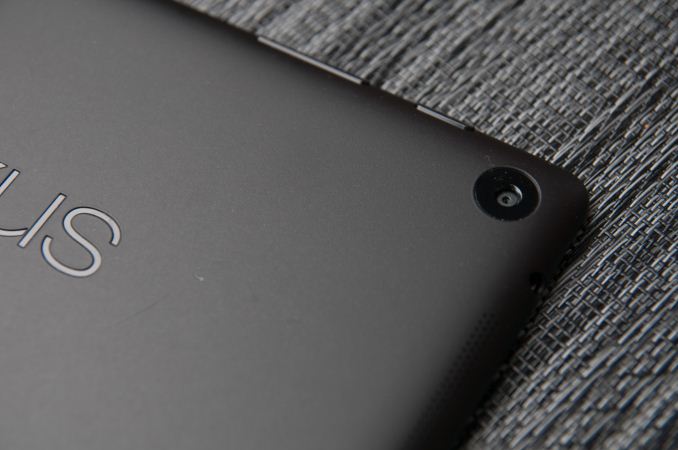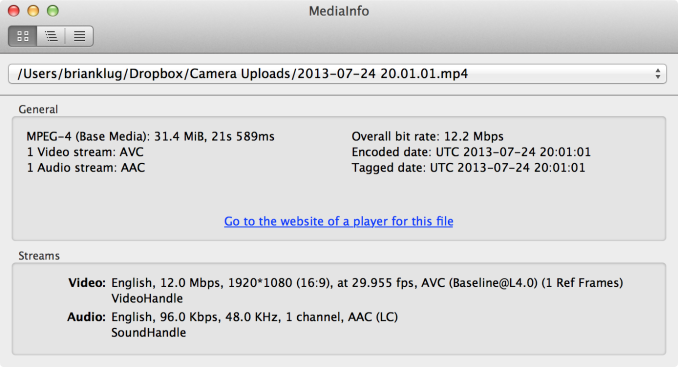Nexus 7 (2013) - Mini Review
by Brian Klug on July 27, 2013 12:54 AM EST- Posted in
- Tablets
- Snapdragon
- Qualcomm
- Android
- Mobile
- APQ8064
- Nexus 7
- Android 4.3
The lack of a rear camera on the original Nexus 7 was always a bit of a downer. It clearly had the space for a module inside, but including a camera didn’t align with the efforts to drive that device into the price point that made it successful. With the new Nexus 7 we finally get a camera, and a 5 MP one with autofocus at that. Inside the camera is an OV5693 sensor, which best I can tell is a 1/4" format sensor with 1.4 micron pixels. It might not be the world’s best camera, but it’s no slouch either.
I took a handful of photos and videos with the Nexus 7 (2013) to gauge camera quality, and even if this isn’t necessarily a device with focus on imaging it’s not bad at all. I came away pretty pleased for what kind of camera it is. Even though I still strongly believe that you shouldn’t be using a tablet to take photos you intend on using for anything more than sharing on social networks, in this brave new era of mobile devices it’s a feature every tablet and smartphone does need.
I’ll save you the discussion once again about how the Android 4.3 camera UI continues to present a 16:9 aspect ratio crop of the 4:3 image captured by the sensor, which results in a smeary looking, inaccurate preview.
Video on the Nexus 7 (2013) is 1080p30 at 12 Mbps, H.264 Baseline with 1 reference frame, and 96 kbps 48 KHz single channel AAC audio. I've uploaded a sample I took in SF to our servers as well as YouTube. Again I’m dismayed why more OEMs don’t use the full encode capabilities of APQ8064 (20 Mbps H.264 High Profile) but that’s what it is by default on the new Nexus 7.



















252 Comments
View All Comments
phillyry - Tuesday, July 30, 2013 - link
Anand also mentioned that it's possible for the different capacities to have different eMMC controllers.However, they didn't last year.
Would be good to know for this year's models.
Broo2 - Saturday, July 27, 2013 - link
There should not be a difference and the 16GB/32GB flash is used only for storage.phillyry - Tuesday, July 30, 2013 - link
Did you read the article?Brian addressed the real lagging issues that Nexus 7 gen. 1 users have been having. He stated that it was likely caused by the storage I/O and that it should be fixed via software.
Point is, storage is usually the performance bottleneck of a system.
et20 - Saturday, July 27, 2013 - link
Thanks for the review.I really appreciate it much more than your standard review format.
I only read those if I'm 90% sure I want to buy the product because they are too long.
phillyry - Tuesday, July 30, 2013 - link
+1Ya, we should have this short, sweet, and immediate reviews initially for all major products.
TareX - Saturday, July 27, 2013 - link
I enjoyed having an Nexus 7 (till it became unbearably buggy, slow, and eventually broke with no trauma)... but I must say, walking around with two Androids is extremely cumbersome. Having apps and files scattered between two devices is annoying... This lead me to the conclusion that I need to invest in a phablet. It comes with the added advantage of excellent battery life on your one and only Android. That said, a viable alternative would be an affordable version of ASUS' Padphone product. But their screen dock is ridiculously overpriced, I can only see a +5.5" phablet as my only choice here. I hope the HTC One Max comes with a split-screen functionality so I wouldn't have to go for the Note III.torp - Saturday, July 27, 2013 - link
How about comparing wifi signal between the nexus 7 old and nexus 7 new? There are spots in my home where the old nexus 7 simply doesn't work, and it's not a big home.Brian Klug - Saturday, July 27, 2013 - link
Good question, I was never a huge fan of the Azurewave WLAN combo inside the original Nexus 7, I believe WCN3660 and its front end might be better. I would need to compare FCC disclosures and do some testing to find out, unfortunately most mobile devices are pretty constrained, and perform around the same (outliers being those with poor enclosure designs).-Brian
torp - Sunday, July 28, 2013 - link
Oh forgot an important data point: i also have an iPad 1 and that one has no problems with wifi anywhere in my home... so basically I could say the nexus 7 old's wifi was a bit crap :)zepi - Saturday, July 27, 2013 - link
When you do a battery life test, could you run one test at much higher brightness level than the standard? On my 3rd Gen iPad I've noticed that the device really struggles with max brightness setting that is more or less required when using the device outside in sunshine.Unlike often far too hefty laptops, people actually carry their tablets around want to use them things on their patios, balconies and outdoor cafeterias.
Otoh, it's not just the peak brightness, but overall visibility and readability of the screen that'd need to be normalised for such testing. Contrast ratios of screens can vary greatly under plentiful exposure to external light, as manufacturers employ different coatings and "clearblack" technologies, not to mention oled vs tft etc.